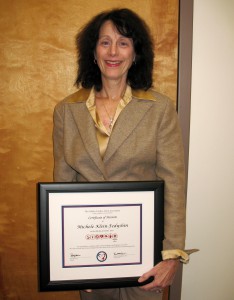 Research shows that the survival rate for those suffering cardiac arrest outside the hospital is only 7%.1 HSLS reference librarian Michele Klein-Fedyshin, who earned her RN last year, used an automatic external defibrillator (AED), along with cardiopulmonary resuscitation (CPR), to assist in the rescue of a Pitt professor who suffered a cardiac arrest at the University Club gym on April 15, 2010. Klein-Fedyshin and Dave Nanz, the responding Pitt police officer, were awarded a certificate of recognition at the annual meeting of the Sudden Cardiac Arrest Association (SCAA) on October 8, 2010.
Research shows that the survival rate for those suffering cardiac arrest outside the hospital is only 7%.1 HSLS reference librarian Michele Klein-Fedyshin, who earned her RN last year, used an automatic external defibrillator (AED), along with cardiopulmonary resuscitation (CPR), to assist in the rescue of a Pitt professor who suffered a cardiac arrest at the University Club gym on April 15, 2010. Klein-Fedyshin and Dave Nanz, the responding Pitt police officer, were awarded a certificate of recognition at the annual meeting of the Sudden Cardiac Arrest Association (SCAA) on October 8, 2010.
AEDs are life-saving equipment in arrest situations, along with CPR. The Pitt campus has placed AEDs in various locations around the campus, and Pitt police carry them in response to medical calls.2 HSLS is purchasing an AED to be placed in the Falk Library lobby. The time saved by having an AED nearby can translate into a life saved. Hopefully, it will never need to be used.
1National Center for Early Defibrillation.
2Kimberly K. Barlow, “Importance of AEDs Hits Home—Twice,” University Times, June 10, 2010.
~ Michele Klein-Fedyshin